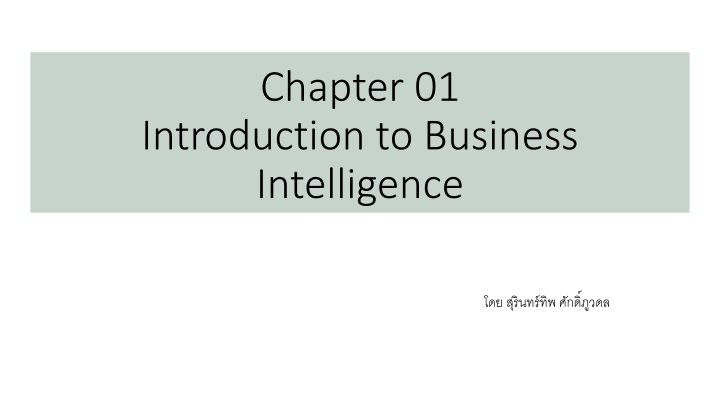
Introduction to Business Intelligence and BI Applications
Explore the concept of Business Intelligence (BI) and its crucial role in aiding enterprises to make informed business decisions by transforming data into valuable information. Learn about BI applications like decision support systems, OLAP, and data mining, essential for strategic insights and decision-making.
Download Presentation

Please find below an Image/Link to download the presentation.
The content on the website is provided AS IS for your information and personal use only. It may not be sold, licensed, or shared on other websites without obtaining consent from the author. If you encounter any issues during the download, it is possible that the publisher has removed the file from their server.
You are allowed to download the files provided on this website for personal or commercial use, subject to the condition that they are used lawfully. All files are the property of their respective owners.
The content on the website is provided AS IS for your information and personal use only. It may not be sold, licensed, or shared on other websites without obtaining consent from the author.
E N D
Presentation Transcript
Chapter 01 Introduction to Business Intelligence
Business Intelligence Business Intelligence By 2000, Information Democracy will emerge in forward-thinking enterprises, with Business Intelligence information and applications available broadly to employees, consultants, customers, suppliers, and the public. The key to thriving in a competitive marketplace is staying ahead of the competition. Making sound business decisions based on accurate and current information takes more than intuition. Data analysis, reporting, and query tools can help business users wade through a sea of data to synthesize valuable information from it today these tools collectively fall into a category called Business Intelligence. (Bert Brijs,pp5)
Business intelligence (BI) Business intelligence (BI) is a broad category of applications and technologies for gathering, storing, analyzing, and providing access to data to help enterprise users make better business decisions. (Bert Brijs,2013) Using a broad definition: Business Intelligence is a set of methodologies, processes, architectures, and technologies that transform raw data into meaningful and useful information used to enable more effective strategic, tactical, and operational insights and decision-making. Under this definition, business intelligence also includes technologies such as data integration, data quality, data warehousing, master-data management, text-and content-analytics, and many others that the market sometimes lumps into the Information Management segment. (Drew Bentley ,2017)
BI applications BI applications include the activities of decision support systems, query and reporting, online analytical processing (OLAP), statistical analysis, forecasting, and data mining. Business intelligence applications can be: Mission-critical and integral to an enterprise s operations or occasional to meet a special requirement Enterprise wide or local to one division, department, or project Centrally initiated or driven by user demand
Business Intelligence is a set of methodologies, processes, architectures, and technologies that transform raw data into meaningful and useful information used to enable more effective strategic, tactical, and operational insights and decision-making. (Drew Bentley ,2017)
BI applications BI applications 1. decision support systems (DSS ) 2. query and reporting ( ) 3.online analytical processing (OLAP) 4.statistical analysis ( ) 5.data mining ( ) (Clustering, classification (Prediction, forecasting), association)
Point of sales Point of sales System
Data for Analysis Technique User Data Source USER Operation Data Historical Data ERP CRM Payroll Point of sales Data warehouse Data mart Historical Data Query and Report OLAP Data mining Data Visualization Data Access ETL DW DM DM DM DM External Data Business intelligence architecture
Data Warehouse, Data Mart Data Source USER MIS, DSS, ESS Database has Tps Database: Sales system DW_Employee DW_Payroll has Emp_ID (PK) Emp_Name Emp_Surname me Job_No (FK) Salary DW_Sales_Detail Payroll_Id (PK) Date Emp_Id (FK) Salary OT_Hour Chg_Hour Commission Total_Amt DW_Sales Receipt_No (PK)(FK) Product_Id (PK)(FK) Product_NameEng Sale_Qty Unit_Price Total_Amt Receipt_No (PK) Cust_Id (FK) SDate Ex_Vat_Amt Vat_Amt Grand_Total_Amt Emp_No (FK) Commission Shop_No (FK) has has has DW_Job has Job_No (PK) Job_Class Chg_hour has DW_Product DW_Shop DW_Customer has Product_Id (PK) Product_NameThai Product_NameEng Unit_Type Unit_Price Balance_Qty Product_Type_Id (FK) Cust_Id (PK) Prefix Cust_Name Cust_Surname Province Country Shop_No (PK) Shop_Name Address Province Country DW_Product_Type Tps Database: Payroll system Product_Type_Id (PK) Product_Type_Name Sales_Date Date Id (Pk) Sale_Date 1..1 is dimension of 0..n Shop Sales Product is dimension of is dimension of Shop Id (Pk) Shop Name Shop Id (Pk)(Fk) Product Id (Pk)(Fk) Date Id (Pk)(Fk) Sales Amount Product Id (Pk) Product Name 1..1 0..n 0..n 1..1
The different components of BI architecture https://enterprizeea.files.wordpress.com/2014/06/bi-business-intelligence-and-data-warehouse.png https://www.researchgate.net/figure/A-Typical-architecture-of-business-intelligence-and-data-sources-to-create-data-warehouse_fig2_281278975
The different components of BI architecture https://www.passionned.com/bi/architecture/
BI Reporting Tool Integrate.io IBM Cognos Micro Strategy Palo OLAP Server Apache Kylin icCube Pentaho BI Mondrian OBIEE JsHypercube Jedox
Reference Business Analysis for Business Intelligence, Bert Brijs, 2013




